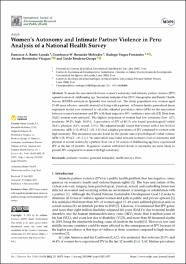Women’s Autonomy and Intimate Partner Violence in Peru: Analysis of a National Health Survey

Ver/
Descargar
(application/pdf: 378.8Kb)
(application/pdf: 378.8Kb)
Fecha
2022-11-03Autor(es)
Barón-Lozada, Francisco A.
Basualdo-Meléndez, Gianfranco W.
Vargas-Fernández, Rodrigo
Hernández-Vásquez, Akram
Bendezu-Quispe, Guido
Metadatos
Mostrar el registro completo del ítemResumen
To assess the association between women’s autonomy and intimate partner violence (IPV) against women of childbearing age. Secondary analysis of the 2019 Demographic and Family Health Survey (ENDES-acronym in Spanish) was carried out. The study population was women aged 15–49 years who are currently married or living with a partner. A Poisson family generalized linear regression model was estimated to calculate adjusted prevalence ratios (aPR) for the association between women’s autonomy and IPV with their respective 95% confidence intervals (CI). Data from 18,621 women were analyzed. The highest proportion of women had low autonomy (low: 42%; moderate: 39.2%; high: 18.8%). A prevalence of IPV of 40.1% was found (psychological/verbal: 38.8%; physical: 8.8%; sexual: 2.3%). The adjusted model found that women with a low level of autonomy (aPR: 1.15, 95%CI: 1.01–1.31) had a higher prevalence of IPV compared to women with high autonomy. This association was also found for the specific case of psychological/verbal violence (aPR: 1.15, 95%CI: 1.01–1.31). No association was found between women’s level of autonomy and physical or sexual violence by a partner. Four out of 10 women of childbearing age have experienced IPV in the last 12 months. In general, women with lower levels of autonomy are more likely to present IPV compared to women with high autonomy.
Palabras clave
Colecciones
- SCOPUS [380]

